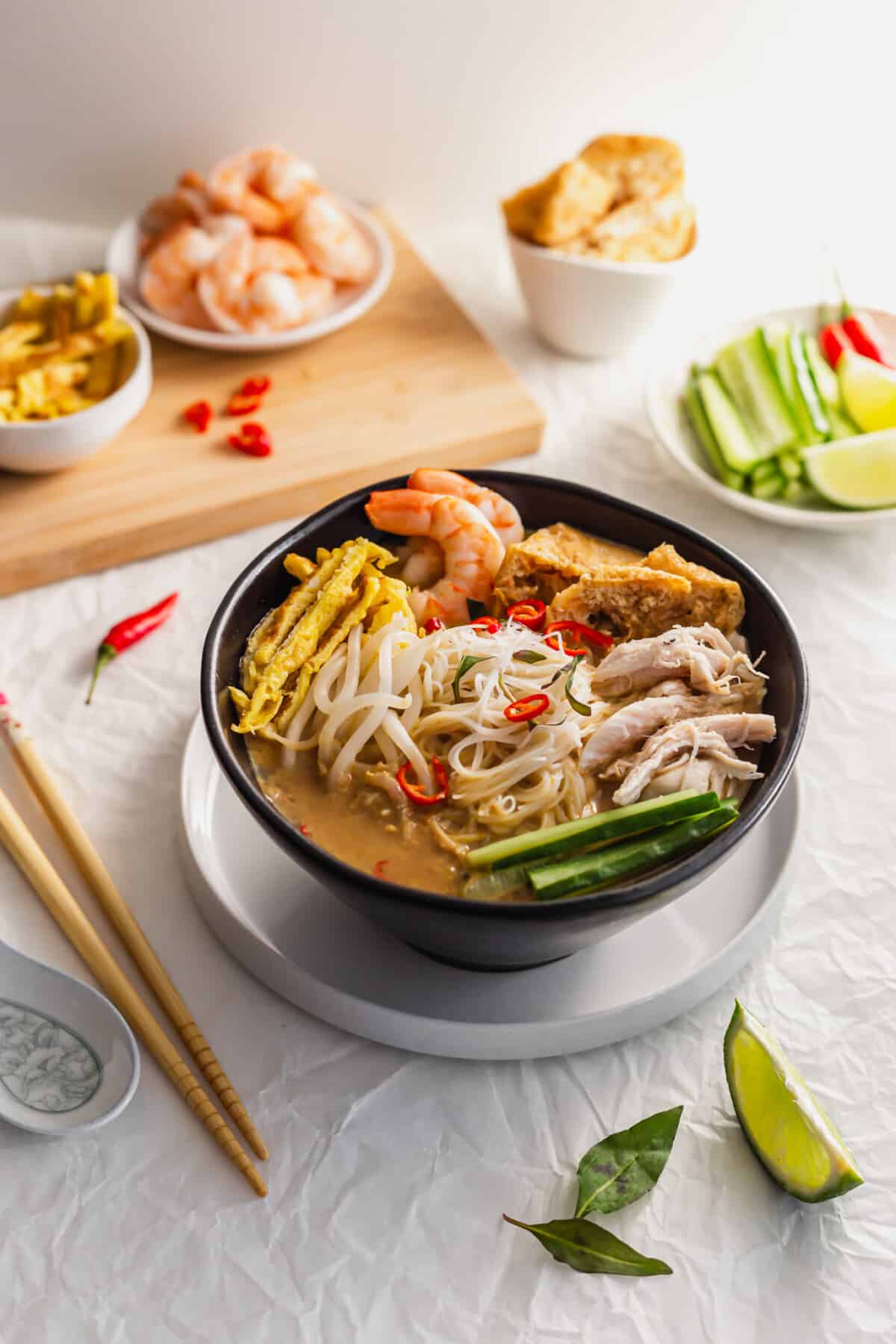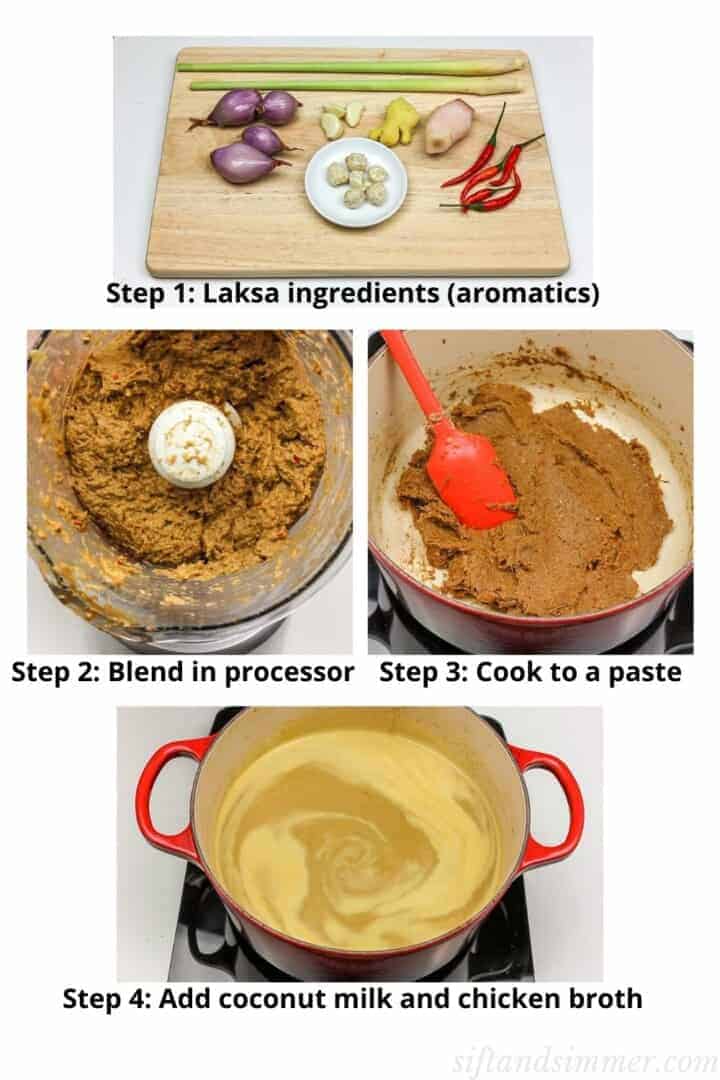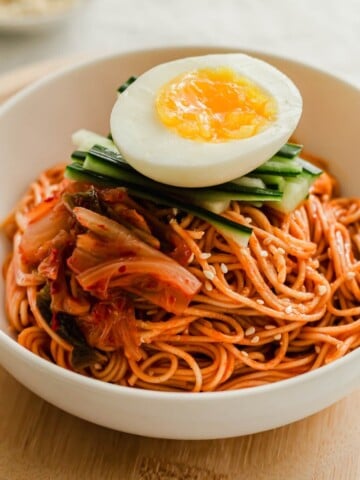This recipe is my Mom's version of Sarawak Laksa: a style of laksa from Malaysia featuring homemade laksa paste that yields a spicy, tangy, rich and aromatic broth. Fine rice vermicelli noodles soak up the thick soup and is topped with shredded chicken, egg, shrimp, cucumbers and bean sprouts.

Want to save this recipe?
Enter your email & I'll send it to your inbox. Plus, get great new recipes from me every week!
If you asked me what my favourite noodle dish is, I will tell you it is my Mom's laksa.
My Mom always made laksa for special occasions like birthdays, or Christmas.
What is laksa?
Generally speaking, laksa is a spicy Southeast Asian noodle soup.
The word "laksa" appears to originate from a Persian word meaning "noodles."
There are many different versions of laksa that currently exist due to the use of various regional ingredients.
Where is laksa from?
Laksa originated from the Peranakan people, which refers to people who are of mixed Chinese-Malay/Indonesian heritage. "Peranakan" means "locally born."
Chinese men, also known as "Babas" would set out onto the spice trade route and settle in their new villages, marrying the local Malay women. The women are known as "Nyonyas."
The Nyonya women oversaw the cooking. Fusing together Chinese and Malay heritage, Nyonya women transformed traditional Chinese dishes with local spices and ingredients, creating a new hybrid cuisine.
This hybrid cuisine blending Malaysian and Chinese food is known as Nyonya food, and laksa is one of its most famous creations.
Where is Sarawak?
Sarawak is a Malaysian state on the island of Borneo.
It is situated on the northwestern side of Malaysia and its capital is Kuching.

Why homemade?
Previously, we would get laksa paste from a famed hawker in Malaysia.
We had packages of laksa paste stashed frozen in our deep freezer from whenever a relative would visit Malaysia or Brunei.
However, as time would pass, our stash would dwindle.
My Mom decided to create her own variation of laksa, making the paste from scratch.
Note: packaged laksa paste contains palm oil and saturated fats, which is why the paste appears to be much more red and oilier than this homemade version.
2 common types of soup for laksa
Laksa is often categorized by the type of soup and noodle.
There are many types of laksa with a plethora of regional variations with a combination of both, but most often, you can find:
- Curry: is primarily a coconut milk-based laksa noodle soup with curry powder
- Asam: is a sour, tangy spicy noodle soup which is flavoured primarily with tamarind paste
This Sarawak-style laksa is somewhat of a hybrid version with both asam (sour/tamarind) and curry/coconut flavour.
What is tamarind?
Tamarind is a sticky, fibrous, brown pod-like fruit with a pulp that is commonly used in cuisines such as Thai and Indian.
It has a sour, sweet and tangy/tart taste.
Tamarind is usually sold either as a ready-made paste, or in packages with dried pulp, where you need to reconstitute it.
Ready-made tamarind paste can be quite watery.
For this recipe, I recommend using dried tamarind pulp, and then hydrating it with warm water. You can find tamarind pulp in Asian supermarkets.
Type of noodles used
Original laksa from the Peranakans uses thick wheat or rice noodles.
Thin rice vermicelli noodles ("bee hoon" or "mei fun") are also used. This Sarawak style noodle uses thin rice vermicelli noodles.
Curry laksa with vermicelli noodles is known as "curry laksa" in Kuala Lumpur and Singapore, however, it is referred to as "Curry Mee" in Penang.
Curry mee contains the same laksa soup, except that thick, yellow alkalized egg noodles are used instead.
Other variants such as Johor laksa use spaghetti noodles in their laksa soup.
Alternatively, udon noodles can be a modern day "cheat" in place of traditional thick laksa noodles.
Moreover, it's very common to mix both rice noodles and wheat/egg noodles in laksa. So feel free to use whatever noodles you have on hand.

Ingredients you'll need
Laksa paste is the foundation of laksa. It's where all that rich, nutty, fragrant flavour is developed.
You can find most of these ingredients in Asian supermarkets, or Vietnamese/Southeast Asian grocers.
For the laksa paste, you'll need:
Aromatics:
- red Thai chilies: chopped, these are also known as bird's eye chilies; if you don't like spicy, you can decrease the number of chilies
- shallots: are light purple in colour; have a sweet flavour with a little sharpness; if you can't find shallot, you can use a medium yellow onion
- ginger: minced, adds a little heat and zing to the soup
- galangal: also known as blue ginger or Thai ginger; it has a similarity to ginger -- except that it has a sharp citrus note. If you're unable to find it, substitute with ginger.
- garlic: minced
- fresh lemongrass: the stalks have a bright, citrus/lemony aroma and are light green/yellow in colour
Spices & nuts:
- candlenuts: also known as candleberry or kukui nut, and can be difficult to find; you can substitute with macadamia nuts, or cashew nuts instead
- coriander powder: comes from the coriander seed with a slightly citrusy aroma
- *cumin powder: comes from cumin seed, which is commonly used in Mexican and Indian dishes
- tamarind pulp: has a sweet and tangy/sour taste; if you have tamarind paste, you can use double the amount as written; if you have dried tamarind pulp, you will need to rehydrate it in warm water until it loosens
- avocado oil: or neutral vegetable oil
- *coconut palm sugar: you can use brown sugar or granulated sugar
- *curry powder: not traditionally found in Sarawak-style laksa; I use a Malaysian-style curry powder, which is a blend of various spices
- *paprika: is a powder that comes from dried red peppers; adds a little heat
- sea salt: seasons the paste
*Not traditionally used in Sarawak laksa, but added for more flavour.
Substitutions
If you can't find tamarind, try using brown sugar and lime juice instead to give it an acidic and sweet tone to the laksa soup.
No candlenuts? Try using macadamia nuts (or cashews) instead.
Can't decide between rice noodles and egg noodles? You can use both!
How to make laksa paste
Add Thai chilies, shallots, ginger, galangal, garlic, lemongrass, candlenuts, coriander powder, cumin powder, tamarind paste (or tamarind pulp + warm water), and oil to a food processor or high-powered blender.
Blend until the lemongrass stalks and chilies processed finely, with no chunks.
Transfer the paste to a heavy-bottomed pot and fry it over medium heat for 30-40 minutes, stirring intermittently.
The aroma of the paste will become fragrant and nutty.
Once the paste has thickened, add in the coconut sugar, curry powder, paprika, and sea salt and continue to cook for another 5 more minutes, stirring every so often, until dark brown and aromatic.
Transfer the pot off the heat.

Watch how to make it
How to store the paste
At this point in time, you can cool down the paste and store it in an airtight container in the fridge for up to 1 week.
Alternatively, you can freeze the laksa paste in a freezer-safe container for up to 6 months.
How to assemble
When you're ready to serve laksa, transfer the laksa paste to a large pot.
Add in 4 C of chicken broth and 1 can of coconut milk and bring to a simmer.
Taste for seasoning and adjust to your liking with additional coconut palm sugar or salt.
Keep the soup hot (at a low simmer) prior to serving.
Once you have the laska soup ready, it's a matter of assembling. Make sure you have a large bowl for all the goodies!
Toppings & garnishes for laksa
- fine rice vermicelli noodles: cooked and drained
- chicken: cooked and shredded
- egg: cooked as an omelette and cut into thin strips
- shrimp/prawns: boiled and split in half
- *tofu puffs: cooked in boiling water, drained and wringed; cut in half (optional)
- bean sprouts: blanched in hot water
- cucumbers: julienned
- fresh lime
- laksa leaf: also known as rau ram or Vietnamese coriander, if available; otherwise garnish with cilantro instead
- Thai chilies: chopped, optional
- belacan: fermented shrimp paste, optional
*Not traditionally added in Sarawak laksa, but added since I like tofu puffs.
How to serve laksa
Add the vermicelli noodles, shredded chicken, egg, shrimp, tofu puffs, bean sprouts, cucumbers to a large serving bowl.
Ladle the hot laksa soup over top of the noodles.
Add a squeeze of lime juice, laksa leaf (rau ram), and Thai chilies if you like it extra spicy.
Enjoy the noodles immediately.
Have leftovers?
I don't recommend storing the already-prepared noodle bowls.
It's better to store the laksa soup separately from the toppings and noodles.
You can store the cooked toppings, laksa soup, and noodles in separate containers in the fridge for up to 3 days.
When you're ready to serve, heat the soup in a pot, and assemble the bowls prior to eating.

FAQs
Can I use different noodles?
Of course, you can tailor the laksa to how you like it.
Some laksa dishes use egg noodles, and some use rice noodles. If you're in a pinch, you can even substitute with spaghetti or udon noodles.
Can I omit the chilies?
Laksa is typically a spicy noodle soup, but you can decrease the number of chilies in the paste.
Should I make the laksa paste ahead of time?
Yes, the laksa paste does take some time to make -- so it's better to split the task and make the paste a day ahead.
Can I add different toppings?
Absolutely. Feel free to add what you like. Other variations can include hardboiled egg, shrimp paste, long beans, and boiled pig's blood.
Other Malaysian recipes you may like
If you enjoy Southeast Asian food, try out these recipes:
Kolo Mee (Dry Malaysian-Style Noodles)
Bubur Cha Cha (Malaysian Coconut Milk Dessert)
Mini Kueh Dadar (Rolled Coconut Crepes)
Let me know if you try my absolute favourite noodle dish in the world -- tag me on Instagram @siftandsimmer or leave me a comment/rating below!

Mom's Sarawak Laksa with Homemade Laksa Paste
For accuracy and precision in baking recipes, use weight (metric) measurements when available.
Ingredients
Laksa Paste:
- 5 small red Thai chilies (bird's eye) stalks removed
- 4 shallots or 1 medium onion chopped
- 1 tablespoon fresh ginger minced
- 1 tablespoon fresh galangal blue ginger, chopped
- 3 cloves garlic minced
- 2 stalks fresh lemongrass cut into large chunks
- 6 candlenuts (or you can use macadamia nuts or a handful of cashew nuts if you can't find candlenut)
- 2 tablespoon ground coriander
- 1 tablespoon ground cumin
- 3 Tbsp (50g) tamarind pulp + ¾ C warm water (or if using tamarind paste, depending on how runny the tamarind paste is, use 4-6 tablespoon and omit the water)
- 2 tablespoon avocado oil or vegetable oil
- 1 tablespoon coconut palm sugar or brown sugar
- 1 tablespoon curry powder Malaysian-style
- 1 tablespoon paprika
- 2 teaspoon sea salt
Soup base:
- 4 C chicken broth add more if you prefer it more soupy
- 1 can coconut milk
Toppings for laksa:
- 1 pkg rice vermicelli noodles (fine) cooked and drained
- 2 seasoned chicken breasts cooked and shredded
- 12 large shrimp/prawns boiled and sliced in half
- 4 large eggs scrambled and cooked omelette-style, cut into thin strips
- 1 pkg tofu puffs boiled and drained
- 1 cucumber julienned
- 1 pkg bean sprouts washed and lightly cooked with hot boiled water
- 2 limes cut into wedges
- laksa leaves (rau ram, Vietnamese coriander) cut into thin strips
- red Thai chilies optional
- belacan (fermented shrimp paste) optional
Instructions
Make the laksa paste:
- In a food processor or high-powered blender, combine the red Thai chilies, shallots, ginger, galangal, garlic, lemongrass, candlenuts (or macadamia/cashew), coriander, cumin, tamarind paste, warm water, and oil. Pulse until a smooth paste is formed.
- Transfer the pureed paste into a large pot and cook over medium heat for about 30-40 minutes, until fragrant, stirring intermittently.
- Once the paste is nutty in aroma and has thickened significantly, add in the sugar, curry powder, paprika, and salt, and cook for another 5 minutes. Again, stirring every so often.
- Turn off the heat.
- If not using the paste right away, let the laksa paste completely cool and store in an airtight container in the fridge for up to 1 week, or freezer for up to 6 months.
Make the laksa soup:
- To the laksa paste, add in 4 C of chicken broth and 1 can coconut milk. Stir and bring to a simmer over medium heat.
- If the consistency of the soup is a little too thick, add a little more chicken broth or water. Keep the soup hot for serving.
Assemble:
- Place the cooked rice vermicelli noodles into a serving bowl. Top with shredded chicken, shrimp, egg, tofu puffs, cucumber, and bean sprouts.
- Ladle the hot soup over top of the noodles. Add a squeeze of lime over top and garnish with laksa leaves (rau ram), additional Thai chilies and belacan (if desired).
- Serve immediately.
Notes
Nutrition
The nutritional information provided should be considered as approximate and is not guaranteed. Please use your best judgment to ensure food is safely prepared and/or a good fit for your diet.







L Chan
Michelle, I have been looking for a Sarawak Laksa recipe that didn't require a ton of ingredients and am glad that I came across your recipe! The laksa paste turned out really well. Some modifications that I did were: letting the cooled Laksa Paste sit in the fridge for 2 days to let the flavours blend and adding just a little Skim Milk instead of coconut milk to the broth/laksa soup mixture. I used my Instant Pot to poach the chicken and used the remaining chicken broth in my broth/laksa soup mixture. I added thinly sliced Tofu Puffs to my bowl along with the other recommended ingredients plus cilantro (I opted out of the prawns and cucumbers and laksa leaves).
The bowl of Sarawak Laksa was delicious and brought back delicious memories from the past! I can't wait to make more Laksa Pastes using your recipe!
Michelle
Thank you so much for trying the recipe! Using the poaching liquid from the chicken is also another great way to add chicken broth to the laksa soup. Love the adjustments you've made 🙂
Beth
This looks amazing and so tasty! I can’t wait to give this a try! My hubby and daughter are going to love this recipe! So excited!
Michelle
Hope you enjoy it, Beth! 🙂
Adrianne
I love laksa and yours looks delicious! The broth and coconut milk base is totally slurp worthy. Can't wait to try it. Thanks!
Michelle
Thank you so much Adrianne. 🙂 Enjoy!
SHANIKA
Wow! This dish looks incredible! I love how flavorful it is! This is really a great weekend meal!
Michelle
Thank you Shanika 🙂
Charla
This looks super tasty and the fact that it's a recipe that has been passed down from your mother makes it more sentimental.
Michelle
Thank you Charla -- absolutely! Love cooking my Mom's recipes and passing on that generational knowledge to my kids 🙂
Linsey
Thank you Michelle! This is the most delicious and healthy laksa as compare to the original Sarawak laksa, which contain a lot of palm oil. We have made this a few times already. We made a big batch of the paste and frozen for later use.
Michelle
That's right, the paste does contain a lot of palm oil so this is a much healthier alternative with just as much flavour 🙂
David @ Spiced
What a fun recipe, Michelle...and it looks absolutely amazing! I learned quite a bit about the fusion of two cuisines here - thanks for sharing that. (I always enjoy knowing more of the backstory behind a recipe...it adds that extra level of interest!) We've still got some chilly days here, and a bowl of this laksa would be quite welcomed!
Aimee Mars
Mom always has the best and most trusted recipes! I've never made laksa before, but this would be a recipe I'd certainly trust. It looks delicious!
Krissy Allori
I was looking for something new and unique to make and this was so delicious!
Lubna
This looks extremely comforting and delicious. Would love to have a bowl right now...
Carrie Robinson
Wow! This looks and sounds do delicious! Definitely need to make this asap. 🙂
Angela
Thank you for all the great history behind the dish. I always enjoy getting to know the origins of a food. There is so much flavor in this laksa. Delicious!
Kim | Give it Some Thyme
I have never had laksa and clearly that needs to change ASAP! Flavors abound in that paste and love that it can even be frozen. And the variety of toppings that go with this soup base make it even better. So delicious, Michelle, and can't wait to try it! Pinned!
April
Love to try this amazing recipe, Michelle. May I know which brand of curry powder should I use? Thanks.
Michelle
Hi April, I used a Malaysian curry powder. https://www.popscreen.com/prod/MTYxMzE4MzIx/Hot-Indian-Curry-Powder-product-of-Malaysia-1-lb